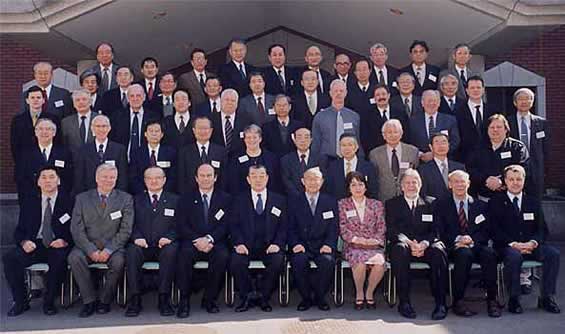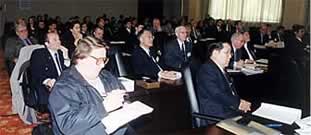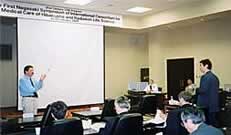| |
 |
Symposium : The First
Nagasaki Symposium |
|
| |
The First Nagasaki
Symposium of International Consortium for
Medical Care of Hibakusha and Radiation Life Science |

The First Nagasaki Symposium of International Consortium for
Medical Care of Hibakusha and Radiation Life Science was held
on February 21-22, 2003 at Pompe van Meerdervoort Hall, Nagasaki
University School of Medicine to commemorate that the International
Consortium for Medical Care of Hibakusha and Radiation Life Science was
selected as one of the COE programs for the year of 2002 by the Ministry
of Education, Culture, Sports, Science and Technology. The number
of participants amounted to more than 120, including guests, delegates
from universities and institutes which have joined or are to join
the consortium and domestic researchers inside and outside the university,
and the symposium was led to success.
The opening ceremony of the symposium was commenced with the opening
address by Dr. Hiroshi Saito, President of Nagasaki University, followed
by addresses of five guests, Dr. Junko Matsubara (Vice Chairperson,
Nuclear Safety Commission), Dr. Shigenobu Nagataki (President, Radiation
Council), Dr. Yasuhito Sasaki (President, National Institute of Radiological
Sciences), Dr. Yoshiro Aoki (Chairman, Radiation Effects Association)
and Dr. Ohtsura Niwa (President, Japan Radiation Research Society),
and ended with introduction to the COE program by Prof. Masao Tomonaga,
Project Leader. The symposium ended the scientific program of the
first day with keynote lectures given by Prof. emeritus Masao S.
Sasaki (Kyoto University), Prof. Geraldine A. Thomas (South West
Wales Cancer Institute) and Prof. James E. Trosko (Michigan State
University). On the second day of the symposium, a total of 16 papers
were presented at the three sessions of “Overview of studies
on atomic bomb survivors,” “Current
results and future plans of epidemiological studies in global radio-contaminated
areas” and “Present state and future plans of research
in the area of low level radiation biology.” Each paper was
discussed actively and the International Consortium for Medical
Care of Hibakusha and Radiation Life Science has embarked on
full-scale activity.
Two 1-day international seminars within the frameworks of International
Consortium for Radiatio Medicine and Epidemiology and International
Consortium for Radiation Life Science were held on February
20 and 23, 2003, respectively as satellite meetings of the symposium.
A number of papers were presented at respective seminars by young
scientists including graduate students of the university as well
as overseas and domestic participants of the symposium, and ideas
about future activities in the two consortiums were exchanged actively.
Papers presented at the symposium and the two seminars were compiled
and published by Elsevier, Amsterdam in November 2003 as the symposium
proceedings entitled Radiation and Humankind. The program
of the symposium was as follows.
| Program |
Venue: Pompe van Meerdervoort Hall
Nagasaki University School of Medicine |
Day 1 (21 February)
| 10:00-11:10 |
Opening ceremony Chair: Shunichi Yamashita,
Nagasaki University
10:00-10:40
Opening address
| |
Hiroshi Saito, President, Nagasaki University |
Addresses
| |
Junko Matsubara, Vice Chairperson, Nuclear
Safety Commission
Shigenobu Nagataki, President, Radiation Council
Yasuhito Sasaki, President, National Institute
of Radiological Sciences
Yoshiro Aoki, Chairman, Radiation Effects Association
Ohtsura Niwa, President, Japan Radiation Research
Society |
10:40-11:10
Introduction to COE program
| |
The International Consortium for Medical Care of Hibakusha
and Radiation Life Science: its concept, structure and
planning
Masao Tomonaga, Project Leader, Nagasaki University |
|
| |
| 11:10-13:00 |
Group photo, Lunch, Press conference |
| |
| 13:00-15:30 |
Keynote lectures Chair: Yutaka Okumura,
Nagasaki University
- Radioadaptive response and genomic instability:
a phenotypic dichotomy of genome-environment interaction
Masao S. Sasaki, Kyoto University
- The Chernobyl Tissue Bank--integrating international
research on thyroid cancer
Geraldine A. Thomas, South West Wales Cancer
Institute, UK
- Hallmarks of radiations carcinogenesis: ignored
concepts
James E. Trosko, Michigan State University,
USA
|
|
| |
| 15:30-16:00 |
Coffee break |
| |
| 16:00-17:00 |
Facility tour |
| |
| 18:30-20:30 |
Reception |
Day 2 (22 February)
| 9:00-12:00 |
Chair: Kuniaki Hayashi, Nagasaki University and Victor Ivanov,
Medical Radiological Research Center of Russian Academy of
Medical Sciences, Russia
Overview of studies on atomic bomb survivors
- The researches at Nagasaki University on atomic
bomb survivors
Ichiro Sekine, Nagasaki University
- The scientific program of RERF
Burton G. Bennett, Radiation Effects Research
Foundation
|
Current results and future plans of epidemiological
studies in global radio-contaminated areas
- Risk of radiogenic malignant and benign thyroid
diseases for the population of the Oryol oblast after
the Chernobyl accident: outcome of large-scale epidemiological
studies
Victor Ivanov, Medical Radiological Research
Center of Russian Academy of Medical Sciences, Russia
- Distinctive features of somatic gene mutagenesis
and apoptosis in radiation exposed individuals and
cancer patients
Alexander Saenko, Medical Radiological Research
Center of Russian Academy of Medical Sciences, Russia
- Overview of research and future prospects in radiation
medicine based on the current health status in Belarus
Pavel Bespalchuk, Belarusian State Medical
University, Republic of Belarus
- Thyroid gland and radiation (Ukraine-U.S. Thyroid
Project)
Mykola D. Tronko, Institute of Endocrinology
and Metabolism, Academy of Medical Sciences of Ukraine,
Ukraine
- Medical consequences of the Chernobyl NPP accident
in Ukraine--reality and planning for future
Volodymyr Bebeshko, Research Center for
Radiation Medicine, Academy of Medical Sciences of
Ukraine, Ukraine
- Current results and future plans of epidemiological
and clinical studies and rehabilitation of the population
in the eastern region of Kazakhstan
Murat Teleiov, Semipalatinsk State Medical
Academy, Kazakhstan
- Data of morphological investigation of some organs
of endocrine and immune systems of the inhabitants
of Semipalatinsk region
Yuriy Pruglo, Semipalatinsk State Medical
Academy, Kazakhstan
|
|
| |
| 12:00-13:30 |
Lunch |
| |
| 13:30-15:50 |
Chair: Masami Watanabe, Nagasaki University and James E.
Trosko, Michigan State University, USA
Present state and future plans of research in the area
of low level radiation biology
- Genomic instability, susceptibility genes, and
carcinogenesis
Robert L. Ullrich, Colorado State University,
USA
- Ionizing radiation-induced signaling pathways
Alex J. van der Eb, Leiden University Medical
Center, The Netherlands
- Application of microbeam techniques in low-dose
radiation biology
Barry D. Michael, Gray Cancer Institute,
UK
- Perpetuating radiation-induced genomic instability
William F. Morgan, University of Maryland,
USA
- Development of photon microbeam irradiation system
for radiobiology
Katsumi Kobayashi, High Energy Accelerator
Research Organization
- The European Masters of Science course in radiation
biology
Kevin M. Prise, Gray Cancer Institute, UK
- Untargeted and delayed mutation in F1 mice born
to irradiated spermatozoa and genomic cross-talk
in sperm irradiated zygotes
Ohtsura Niwa, Kyoto University
|
|
| |
| 15:50-16:10 |
Coffee break |
| |
| 16:10-16:50 |
General discussion Chair: Masao Tomonaga and Masami
Watanabe, Nagasaki University |
| |
| 16:50 |
Closing remarks Masao Tomonaga,
Nagasaki University |
|
|


